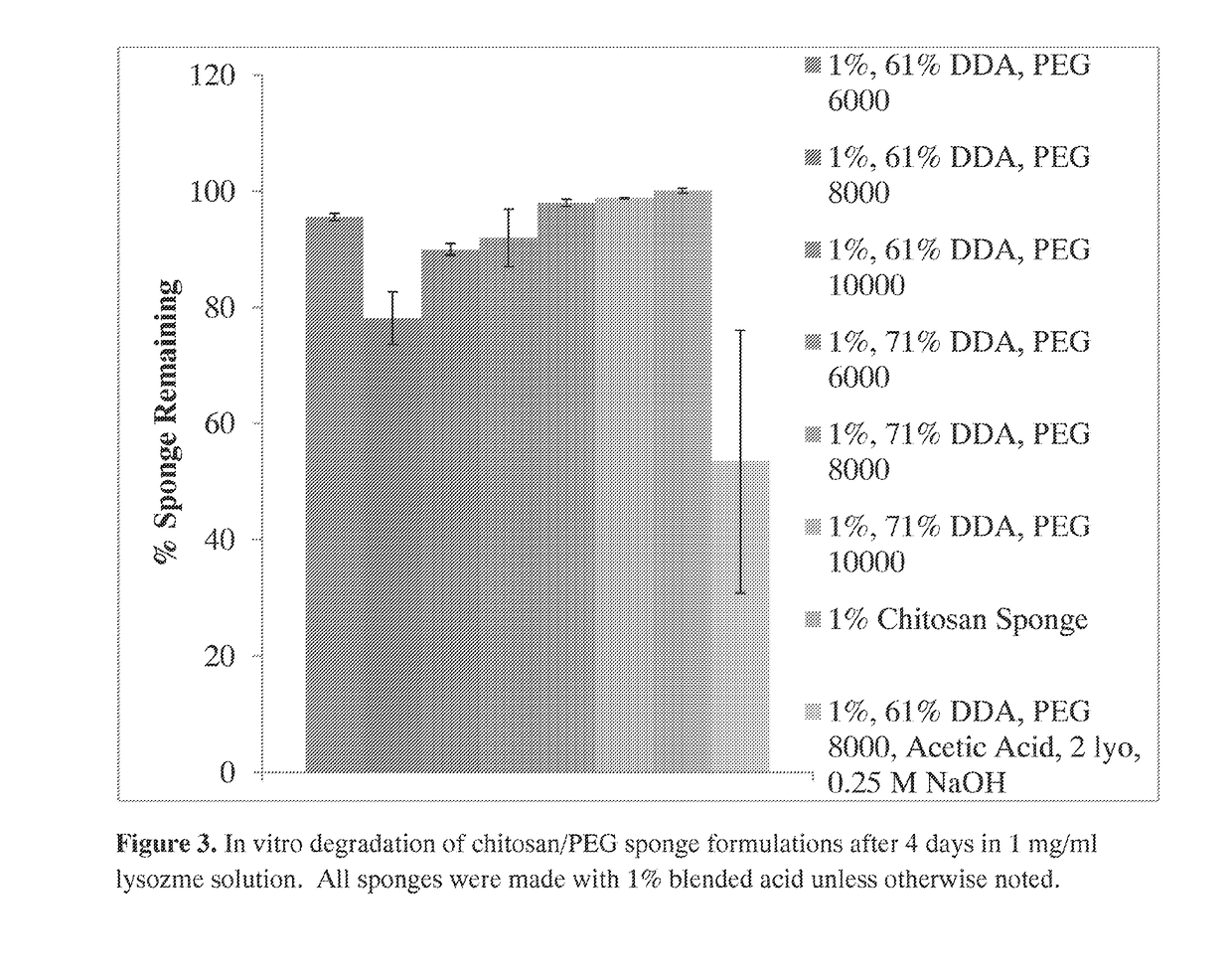Compositions and methods for delivering an agent to a wound
- Summary
- Abstract
- Description
- Claims
- Application Information
AI Technical Summary
Benefits of technology
Problems solved by technology
Method used
Image
Examples
example 1
ic Antifungal Agents are Loaded and Released from Chitosan-PEG Sponges
[0180]Polymicrobial musculoskeletal infections, especially from invasive bacteria, fungi or biofilm pathogens, are challenging complications that often increase patient morbidity, mortality, and hospitalization costs (Murray et al., J Trauma 64:S239-251). The clinical need for degradable local antimicrobial delivery systems to fight localized bacteria, fungi, and / or biofilms with patient-tailored antimicrobial point-of-care loading has resulted in the previous development of a chitosan sponge local delivery system (Hanssen, Clin Orthop Relat Res:91-96; Noel et al., Clin Orthop Relat Res 468:2074-2080; Stinner et al., J Orthop Trauma 24:592-597). The present study was designed to determine if the blending of these chitosan sponges with polyethylene glycol would result in local drug delivery systems capable of antifungal and antibiotic release for the prevention of polymicrobial wound infections.
[0181]A set of chito...
example 2
rier Transform Infrared Spectroscopy) Analysis of Chitosan / PEG Blended Sponges
[0235]FTIR (Fourier transform infrared spectroscopy) analysis of the chitosan / PEG blended sponges and control chitosan sponges was performed (FIG. 11). The presence of PEG in the sponges was confirmed by FTIR. Characteristic peaks were seen in the 1% chitosan sponges at 3290 cm−1 (O—H stretching), 1643 cm−1 (amide I C═O stretching), and 1557 cm−1(amide II N—H) (Wang et al. J Biomed Mater Res Part A 2008; 85(4):881-7; Kolhe et al. Biomacromolecules 2003; 4(1):173-180; He et al., Chin J Polym Sci 2009; 27(4):501-510). Characteristic C—O bending peaks were observed in PEG 6000 and 8000 at 1093 cm−1, and peaks from the crystalline region of PEG were observed at 1278, 960, and 840 cm−1 (Wang et al. J Biomed Mater Res Part A 2008; 85(4):881-7; Kolhe et al. Biomacromolecules 2003; 4(1):173-180).
[0236]All blended sponges exhibited the characteristic chitosan O—H stretching peaks at 3357-3360 cm−1. All peaks were s...
example 3
fraction (XRD) Analysis of Chitosan / PEG Blended Sponges
[0238]X-ray diffraction results revealed a difference between the chitosan powder and all sponge types (FIG. 12A). Analysis of the XRD spectra of the chitosan powder indicated the presence of anhydrous chitosan crystal structure (Ogawa et al., Agric Biol Chem 1991; 55(9):2375-2379). The chitosan powder exhibited the typical crystalline peak at approximately 20°, but this peak disappeared upon manufacturing the powder into sponges, both in the control chitosan sponges or the chitosan / PEG blended sponges. After chitosan dissolution and lyophilization, the crystalline peak at 20° disappeared and the 10° peak decreased and became broader, suggesting a large loss in helical crystalline forms (Zhang et al., Carbohydr Res 2005; 340(11):1914-7). Additionally, the peak at approximately 12° in the chitosan powder decreased upon sponge manufacturing, and the 1% chitosan, chitosan / PEG 6000 2 lyo, and chitosan / PEG 8000 1 lyo sponges displaye...
PUM
| Property | Measurement | Unit |
|---|---|---|
| Fraction | aaaaa | aaaaa |
| Time | aaaaa | aaaaa |
| Time | aaaaa | aaaaa |
Abstract
Description
Claims
Application Information
 Login to View More
Login to View More - R&D
- Intellectual Property
- Life Sciences
- Materials
- Tech Scout
- Unparalleled Data Quality
- Higher Quality Content
- 60% Fewer Hallucinations
Browse by: Latest US Patents, China's latest patents, Technical Efficacy Thesaurus, Application Domain, Technology Topic, Popular Technical Reports.
© 2025 PatSnap. All rights reserved.Legal|Privacy policy|Modern Slavery Act Transparency Statement|Sitemap|About US| Contact US: help@patsnap.com



